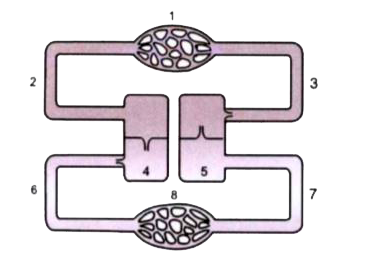Q.) Name the blood cells, whose reduction in number can cause clotting disorder, leading to excessive loss of blood from the body.
a) Erythrocytes
b) Leucocytes
c) Neutrophils
d) Thrombocytes
The correct Answer is:D
Step-by-Step Solution:
1. Understand the Question: The question asks for the type of blood cells whose reduction can lead to a clotting disorder and excessive blood loss.
2. Identify the Types of Blood Cells: There are three main types of blood cells:
- Erythrocytes (Red Blood Cells - RBC)
- Leukocytes (White Blood Cells - WBC)
- Thrombocytes (Platelets)
3. Function of Each Blood Cell Type:
- Erythrocytes (RBC): These cells are primarily responsible for transporting oxygen and carbon dioxide in the blood.
- Leukocytes (WBC): These cells are part of the immune system and help the body fight infections.
- Thrombocytes (Platelets): These cells are crucial for blood clotting. They help in the formation of blood clots to stop bleeding.
4. Determine the Role in Clotting: Since the question specifically mentions a "clotting disorder," we need to focus on thrombocytes (platelets). A reduction in the number of platelets can lead to conditions such as thrombocytopenia, which impairs the body's ability to form clots.
5. Conclusion: Based on the functions of the blood cells, the correct answer to the question is Thrombocytes (Platelets). Their reduction can indeed cause clotting disorders, leading to excessive loss of blood.
Final Answer: Thrombocytes (Platelets)
---
- Erythrocytes (Red Blood Cells - RBC)
- Leukocytes (White Blood Cells - WBC)
- Thrombocytes (Platelets)
- Erythrocytes (RBC): These cells are primarily responsible for transporting oxygen and carbon dioxide in the blood.
- Leukocytes (WBC): These cells are part of the immune system and help the body fight infections.
- Thrombocytes (Platelets): These cells are crucial for blood clotting. They help in the formation of blood clots to stop bleeding.
Topper's Solved these Questions
- TEST PAPERBOOK - NCERT FINGERTPS ENGLISHCHAPTER - TEST PAPEREXERCISE - Practice Paper-3
50 Videos
- TEST PAPERBOOK - NCERT FINGERTPS ENGLISHCHAPTER - TEST PAPEREXERCISE - Test Paper 1
50 Videos
- TEST PAPERBOOK - NCERT FINGERTPS ENGLISHCHAPTER - TEST PAPEREXERCISE - Test Paper 3
50 Videos
- STRUCTURAL ORGANISATION IN ANIMALSBOOK - NCERT FINGERTPS ENGLISHCHAPTER - STRUCTURAL ORGANISATION IN ANIMALSEXERCISE - Structural Organisation In Animals
129 Videos
- THE LIVING WORLDBOOK - NCERT FINGERTPS ENGLISHCHAPTER - THE LIVING WORLDEXERCISE - The Living World
130 Videos
Similar Questions
Name the blood cells, whose reduction in number can cause clotting disorder leading to excessive loss of blood from body
View SolutionName the cells which help in clotting of blood in mammals
View SolutionA reduction in the number of which formed element of blood can lead to clotting disorders
View SolutionBlood cells that protect the body from diseases are the
View SolutionPhotosynthesis is a bio process by which plants make energy rich molecules from low energy molecules with the help of energy from sunlight . The photosynthesis of glucose can be represented as:
6CO2(g)+6H2Og+hv→C5H12O6(s)+6O2(g)..........(i)
The energy of one mole of a photon of wave lenght is known as one Einstein.
A weight lifter lifts a weight of 160Kg through of 2.4 m . Assuming all the energy required for this task is obtained by the combustion of glucose , calculate the change in the current produced by a sample of blood of the weight lifter . Same volume of blood (5mL) is tested both before and after lifting the weight and the total volume of blood in his body is 5L. (1 g of glucose releases 15.58 KJ of energy )
View SolutionWhat is the name given to the excessive production of white blood cells leading to cancer
View SolutionGiven below is a simple diagram of the circulation of blood in a mammal showing the main blood vessels, the heart, lungs and body tissues. The

blood vessels, labelled 6, contain deoxygenated blood and the valve leading to it has three semi- lunar pockets
Name the blood vessels or organs marked by numbers 1 to 8
View Solutiona. Amphibians and reptiles have a 3 chambered heart with ___ atria and ___ventricle.
b. Heart is ___ derived organ and protected by a double walled membranous bag called ____
c. The opening between right Atrium and Right ventricle is guarded by a valve formed of ___ muscular flaps, the ___ valve.
d. The wall of ventricle is ____ than atria.
e. SAN can generate the maximum number of action potential i.e., ____ min−1. therefore it is called _____
f. Atrial systole increases the flow of blood into the ventricles by about ____ percent.
g. In ____ all the four chambers of the heart are in a relax state.
h. The ____ wave represents the depolarisation of the atria.
i. A system of blood vessels is present in our body exclusively for the circulation of blood to and from the cardiac musculature called _____
j. PNA ____ the rate of heart beat and ______
View SolutionCells of human blood can be arranged in a series of increasing number per cubic millimeter of blood as follows
View SolutionDraw the diagram of sectional view of human heart and on it name and label the following parts:
(a) The chamber of the heart that pumps out deoxygenated blood.
(b) The blood vessel that carries away oxygenated blood from the heart.
(c ) The blood vessel that receives deoxygenated blood from the lower part of our body.
View Solution
